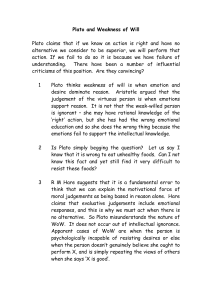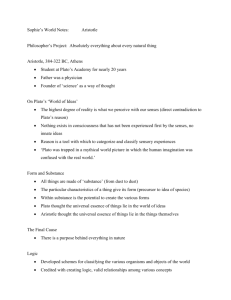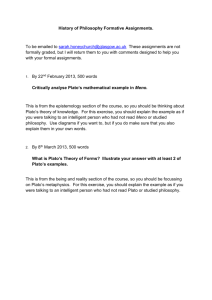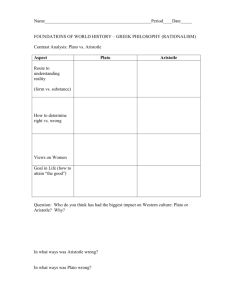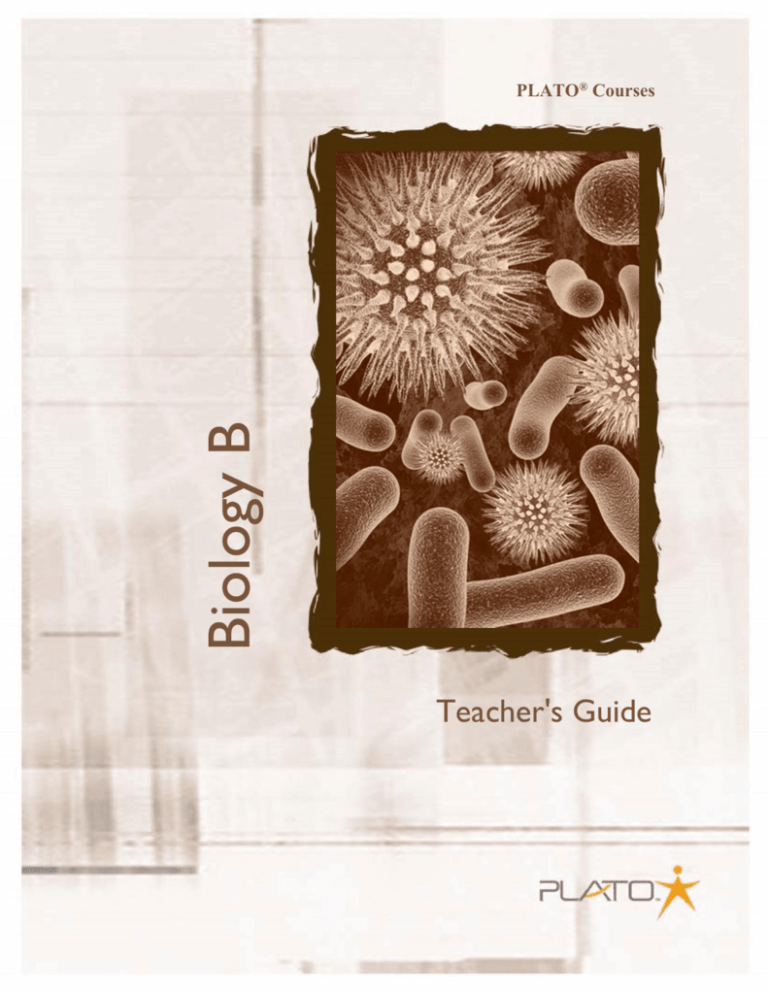
PLATO® Courses
Teacher's Guide
Table of Contents
Biology B
Overview .............................................................................................................................................................3
Course Components...........................................................................................................................................4
Course Implementation Models ..........................................................................................................................7
Biology B Overview ............................................................................................................................................8
Biology B Curriculum Contents and Pacing Guide ...........................................................................................10
Unit 1: Diversity of Life, Part 1 ...................................................................... Error! Bookmark not defined.
Unit 2: Diversity of Life, Part 2 .....................................................................................................................11
Unit 3: Plant Structure and Function ............................................................ Error! Bookmark not defined.
Unit 4: Animal Structure and Function, Part 1 .............................................. Error! Bookmark not defined.
Unit 5: Animal Structure and Function, Part 2 .............................................................................................14
Unit 6: Ecology Summary ............................................................................. Error! Bookmark not defined.
Copyright © 2010 PLATO Learning, Inc. All rights reserved. PLATO® is a registered trademark of PLATO Learning, Inc. Straight Curve, Academic Systems,
and PLATO Learning are trademarks of PLATO Learning, Inc. PLATO, Inc. is a PLATO Learning, Inc. company.
PLATO® Courses
Teacher’s Guide—Biology B
Overview
PLATO Courses are developed to give the instructor many different ways to engage various
learning modalities and to give the student an opportunity to experience a range of standards
and objectives to ensure academic success.
PLATO Courses integrate PLATO online curriculum, electronic learning activities, and
supporting interactive activities. An array of assessment tools allows the instructor to
correctly place students at the appropriate learning level, to evaluate strengths and needs, to
create individualized learning goals, and to determine proficiency. Reports assist in
understanding where the student needs to focus to be academically successful as measured
against objectives. Guidelines and tools are provided to track student progress and to
determine a final course grade.
PLATO Courses give the instructor control over the instructional choices for individual
students as well as for the classroom. The instructor may use all of the components as
sequenced or select specific activities to support and enhance instruction. PLATO Courses can
be used in a variety of ways to increase student achievement.
3
PLATO® Courses
Teacher’s Guide—Biology B
Course Components
Learning Activities—Five types of learning activities are available in PLATO Courses:
•
Tutorials—The tutorials are modules with direct instruction and practice interactions.
Instruction engages learners through the use of videos, animations, interactive
timelines, and click-to-see graphics. Practice interactions include drag-and-drops,
ordered problem solvers, multiple-choice questions, and fill-in-the-blank questions that
all help students check their progress at mastering new concepts. Some tutorials also
include web links to informational sites, games, and videos, which broaden students'
access to information on the topic.
•
Explorations—The explorations are modules that use constructivist approaches to
encourage students to investigate concepts and, thereby, build a deeper understanding.
The explorations include web links, where appropriate, that provide additional
information on the topic at hand. The links also provide opportunities for learners to
engage in multiple forms of media, such as videos and games, related to the concepts
being taught.
•
Lesson Activities—The Lesson Activities are embedded in the tutorials and
explorations. Some activities ask students to examine specific concepts and their
applications. Other activities are designed to reinforce concepts through practice. The
activities are in the form of offline documents where students can record their
responses.
•
Discussions—Discussion interaction with instructors and other students is a key 21st
century skill and learning method. An online threaded discussion mirrors the
educational experience of a classroom discussion. Instructors can initiate a discussion
by asking a complex, open-ended question. Students can engage in the discussion by
responding to the question and to the thoughts of others. Discussions encourage
students to participate more actively in learning.
•
Unit Activities—A culminating activity is included at the end of each unit. The
activity gives students an opportunity to consolidate their learning across lessons in the
unit and exercise higher order thinking skills. Unit activities supply a document for
offline use by students to record results.
Learning aids within the courseware activities assist students. In Biology B, these learning
aids, or tools, include the following:
•
Tutorials and Explorations
o Notebook—The Notebook is an online version of a paper notebook. Students can
take notes on important points, edit them, and refer to them to refresh their
knowledge.
4
PLATO® Courses
o
Teacher’s Guide—Biology B
Calculator— The Calculator, which supports basic operations, is available in case
students do not have access to a handheld calculator.
Assessment and Testing— Best practices in assessment and testing call for a variety of
activities to evaluate student learning. Multiple data points more accurately present an
evaluation of student strengths and needs. Some assessment activities also serve as
learning activities to provide authentic learning and assessment opportunities. These
activities are designed to encourage higher order cognitive thinking, and most focus on
real-world applications and/or 21st century skills. Note that assessment items are
available for each tutorial and exploration in PLATO Courses. In support of this model of
evaluation, PLATO Courses include the following:
•
Lesson Activities are embedded in the tutorials and explorations. They are designed
to encourage investigation and to provide practice. Each activity has an answer key
that provides answers for single-answer questions and objective rubrics along with
sample answers for open-ended questions. Students need to submit some activities
through PLE’s Digital Drop Box for instructor evaluation and feedback. Other activities
can be checked by students themselves using the answer key. Keep in mind that some
students may need guidance to successfully self-check open-ended questions against a
model.
•
Discussions encourage students to reflect on concepts, articulate their thoughts, and
respond to the views of others. Thus, discussions help assess students’ critical thinking
skills. Each unit in a course has one predefined discussion topic along with a rubric for
grading responses. Instructors can include additional discussion topics.
•
Unit Pretests are provided for each course unit. The purpose of these assessments is
to determine a student’s existing knowledge. If the student scores the prescribed
percentage on a unit pretest, he or she may be exempted from completing the related
courseware. Note, however, that this feature is primarily designed for credit recovery
purposes. For first-time credit, students are typically not allowed to “test out” of course
lessons.
•
Mastery Tests at the end of the tutorials and explorations provide the instructor and
the student with clear indicators of areas of strength and weakness. These tests are
taken online.
•
Unit Activities give students the opportunity to apply and integrate concepts that
they have learned across lessons within a course unit and, thereby, demonstrate higher
order thinking skills. Students can use the Digital Drop Box to electronically submit
their work for grading by the instructor.
•
Unit Posttests help instructors track how well students have mastered a unit’s
content. The tests are multiple-choice and are provided online and offline.
5
PLATO® Courses
•
Teacher’s Guide—Biology B
End-of-Semester Tests assess the major objectives covered in the course.
By combining the unit pretest and unit posttest information with the end-of-semester
test results, the instructor will gain a clear picture of student progress.
Subjective Assessment—Of the assessment tools listed above, three are designed
specifically to address higher level thinking skills and operations: Lesson Activities, Unit
Activities, and Discussions. All of these activities allow the instructor to score work on a
scale of 0 to 100.
Lesson Activities and Unit Activities employ the Digital Drop Box, which enables students
to submit work in a variety of electronic formats. This feature provides a wide range of
authentic learning and assessment opportunities for courses. PLATO Learning provides
keys for PLATO-designed Digital Drop Box activities. These keys range from simple
rubrics to detailed sample responses. Online discussions may use whatever rubric the
instructor sets. A suggested rubric is provided here for your reference.
Relevance of
Response
Content of
Response
Online Discussion Rubric
D/F 0-69
C 70-79
B 80-89
Below
Basic
Proficient
Expectations
Responses do
Some responses Responses are
not relate to the are not on topic typically related to
discussion topic or are too brief
the topic and
or
low
level;
or responses are
initiate further
responses
may
inappropriate or
discussion
be
of
little
value
irrelevant
(e.g., yes or no
answers)
Unclear
Does not
Ideas are
present ideas in presentation of
presented
a coherent or
ideas with little coherently,
logical manner; evidence to back although there is
has many
some lack of
them up; errors
connection to the
grammar or
in grammar or
topic; few errors in
spelling errors
spelling
grammar or
A 90-100
Outstanding
Responses are
consistently on topic
and bring insight
into the discussion,
which
initiates additional
responses
Ideas are expressed
clearly, with an
obvious connection
to the topic; rare
instances of
grammar or
spelling errors
spelling
Participation Does not make
any effort to
participate in
the discussion
Participates in
some discussions
but not on a
regular basis
6
Participates in
most
discussions on a
regular basis but
may require some
prompting to post
Consistently
participates in
discussions on a
regular basis
PLATO® Courses
Teacher’s Guide—Biology B
Course Implementation Models
PLATO Courses give instructors the flexibility to define implementation approaches that
address a variety of learning needs. Instructors can configure the courses to allow individual
students to work at their own pace or for group/class learning. Furthermore, the courses can
be delivered completely online (that is, using a virtual approach) or include both face-to-face
and online components (that is, using a blended approach). Depending on the learner grouping
and learning approach, instructors can choose to take advantage of peer-to-peer interaction
through online discussions. Similarly, if students have prior knowledge of the concepts taught
in certain lessons, instructors can decide to employ unit pretests to assess students’ prior
knowledge and exempt them from taking the lessons. Note, however, that this feature is
primarily designed for credit recovery purposes. For first-time credit, students are typically
not allowed to “test out” of course lessons. The following are two common implementation
models for using PLATO Courses, along with typical (but not definitive) implementation
decisions.
•
Independent Learning
Student is taking the course online as a personal choice or as part of an alternative
learning program.
Learner grouping: Independent learning
Learning approach: Blended or virtual
Discussions: Removed from learning path
Unit Pretests: Students do not take pretests
•
Group/Class Learning
Online course is offered for a group of students. These students may not be able to
schedule the specific course at their local school site, or they may simply want the
experience of taking an online course.
Learner grouping: Group interaction
Learning approach: Blended or virtual
Discussions: Used; additional discussion questions may be added Unit
Pretests: Students do not take pretests
7
PLATO® Courses
Teacher’s Guide—Biology B
Biology B Overview
Course Structure
The Biology B Course refers to semester B, and comprises units of lessons on related topics. It
is designed to be completed in 18 weeks. This blended online course is organized into units
and lessons. Each lesson incorporates multiple learning activities designed to develop, apply,
and assess specific learning objectives. The course, as well as each unit in the course, is based
on a researched scope and sequence that covers the essential concepts of biology.
Pedagogical Approach
In order to generate skills for lifelong learning and to employ the most appropriate learning
approach for each topic, 25 percent of the lessons use student-driven, constructivist
approaches for concept development. For example, the lesson on animal bodies from unit 4
provides multiple opportunities for learners to take on-screen instruction about the
organization of an animal body into cells, tissues, organs, and organ systems. The learner then
identifies the microscope slides of tissue samples and explores the heart and skeleton system
through a simulation. The experience of going from explanation of the concept to constructing
an illustration of it moves the learner’s understanding of those discoveries to a deeper level.
The remaining lessons employ direct-instruction approaches. The lessons in the course include
application and inquiry-oriented activities that facilitate the development of higher order
cognitive skills such as logical reasoning, sense making, and problem solving. These activities
also expose students to current technologies, such as the Internet, word processors, and
spreadsheets. Furthermore, each unit in the course includes a predefined discussion topic.
These discussions provide an opportunity for discourse on specific biology concepts and their
STEM applications. Thus, the course encourages the development of critical 21st century
skills.
For example, the lesson “The Endocrine System” in unit 4, starts with a young high school
student who consults her family doctor when she shows certain symptoms. The doctor, after
certain tests, refers her to an endocrinologist. The high school student finds that
endocrinologists are doctors who specialize in the diagnosis and treatment of conditions
affecting the endocrine system. This structure models the STEM career paths open to students
and provides a method for students to explore and discover their own path to a STEM career.
As often as possible, lessons include inquiry-based approaches to new material. In particular,
the 5 Es approach is adapted for use in this course, asking learners to Engage, Explore,
Explain, Elaborate, and Evaluate. The lesson “Angiosperms” in unit 3 provides a good
example of this strategy. The lesson is structured around a series of activities in which the
learner dissects flowers. This approach provides learners with a chance to experience the
properties of water and form their own sense of the central ideas in the lesson.
Practice is an integral part of the lessons in the course. Practice is provided through standard
multiple-choice questions; advanced interactions such as click-to-sees and drag-and-drops;
and fun, interactive, research-based tools and simulations.
8
PLATO® Courses
Teacher’s Guide—Biology B
Lab Components
The lab activities for science subjects provide learners with hands-on exposure to the scientific
concepts they are studying and exploring. Science instruction is as much about learning how
to do science as it is about developing a conceptual understanding. Labs bring those two
elements together.
This course uses a blended model for lab experiences. Some lab experiences are provided using
online and alternative approaches as noted below. The four primary lab experiences that form
the basis of this course are designed to be conducted in person with the planning and guidance
of a teacher.
Alternate approaches
• Informal labs—Sometimes called “kitchen sink” labs, these activities use materials
readily available at home or in non-lab facilities within a school. They will provide true
hands-on exposure to phenomena without the use scientific experimental equipment.
For example, the lesson “Angiosperms” described above includes informal hands-on
experiences, which does not require lab equipment to carry out.
•
Interactive simulations—These rich, interactive simulations are open-ended and
multi-dimensional. They allow learners to adjust various factors in a simulated
experimental situation to see how the outcome of the procedure changes in reaction to
their inputs. The simulations allow for open-learner exploration, as well as more
structured and guided inquiry into various phenomena. For the lesson “The Nervous
System” in unit 5, an online simulation on color vision provides learners with the
chance to change the variables in red-green-blue (RGB) bulbs and observe the resulting
color that a human eye perceives. It provides another option of selecting a single bulb,
where the learner can select the bulb type and beam view and then observe its effect on
the color perceived by the human eye.
•
Analysis of experimental data—Experiencing the practice of science need not
involve doing every step of the gathering of data by hand. Many scientists share data
sets from observations or experiments, and the questions posed, calculations
performed, and the analysis and interpretation of the results can be quite a powerful
lab experience. The tasks included in this course will point learners to existing data
sets, show them an analytical approach, and then ask them to perform calculations,
graph, analyze, and report back on that data using solid principles of scientific inquiry.
•
Simulated labs—Using various media, such as videos and microscope slides, learners
will observe experiments virtually and then carry out analysis and interpretation of
that experience as if they had performed the steps themselves. The lesson “Animal
Bodies” in unit 4 provides an example of this alternate approach to labs. It uses a series
of photographs of microscope slides to simulate the experience of various tissue
samples. The microscope slides are presented for the learner to identify the tissues and
their sub types.
9
PLATO® Courses
Teacher’s Guide—Biology B
Biology B Curriculum Contents and Pacing Guide
This course is split into six units spread across 18 weeks. Use it as a guide and
redesign it to fit your instructional needs and class schedule. The following curriculum
contents provide a brief summary of the course units in each semester. The Unit
Pacing Guide provides a general timeline for presenting this unit. This guide is
designed to fit your class schedule and is adjustable.
Unit 1: Diversity of Life Part I
Summary
This unit explores how scientists classify different life forms in order to understand them
better. It begins with the concept of the tree of life and explains how our modern system
of taxonomy is hierarchical in nature and how this taxonomy reflects evolutionary
relationships. The units then goes on to explore the biology, diversity, evolution, and
importance of domains and kingdoms, including prokaryotes, protozoa, algae, and fungi.
Day
1 day:
1
1 day:
2
1 day:
3
2 days:
4-5
2 days:
6-7
2 days:
8-9
2 days:
10-11
Activity/Objective
Syllabus and Plato Student Orientation
Review the Plato Student Orientation and Course Syllabus at the beginning of this
course.
The Tree of Life
Explain how our modern system of taxonomy is hierarchical in nature.
Phylogeny and Evolution
Describe how taxonomy reflects evolutionary relationships.
Type
Course
Orientation
Tutorial
Exploration
Prokaryotes
Demonstrate knowledge of the biology, diversity, evolution, and importance of the
prokaryotes.
Tutorial
Protozoa
Demonstrate knowledge of the biology, diversity, evolution, and importance of the
protozoa within kingdom Protista.
Tutorial
Algae
Demonstrate knowledge of the biology, diversity, evolution, and importance of the
major algae types within kingdom Protista.
Tutorial
Fungi
Demonstrate knowledge of the biology, diversity, evolution, and importance of the
Fungi.
Tutorial
10
PLATO® Courses
Teacher’s Guide—Biology B
2 days:
12-13
Unit Activity and Discussion—Unit 1
Unit Activity
Discussion
1 day:
Posttest—Unit 1
Assessment
14
Unit 2: Diversity of Life, Part 2
Summary
This unit continues with the remaining two kingdoms, Plantae and Animalia, and
explores the major types of plants and animals. It begins by covering the biology,
diversity, evolution, and importance of vascular plants and of nonvascular plants like
mosses and other bryophytes. The unit then moves on to the kingdom Animalia,
explaining the phylogenetic tree of animal kingdom evolution and the characteristics
used to classify animals. The unit lists the nine major phyla of the animal kingdom called
porifera, cnideria, platyhelminthes, nematoda, molluska, annelida, arthropoda,
echinodermata, and chordata. This unit then explores the biology, diversity, evolution,
and importance of these phyla under three headings: lower invertebrates, higher
invertebrates, and chordata.
Day
1 day:
15
Activity/Objective
Moss and Other Bryophytes
Type
Tutorial
Demonstrate knowledge of the biology, diversity, evolution, and importance of the
non-vascular plants.
2 days:
Vascular Plants
16-17
Demonstrate knowledge of the biology, diversity, evolution, and importance of the
vascular plants.
2 days:
Lower Invertebrate Animals
18-19
Demonstrate knowledge of the biology, diversity, evolution, and importance of the
lower invertebrates.
2 days:
Higher Invertebrate Animals
Demonstrate knowledge of the biology, diversity, evolution, and importance
of the higher invertebrates.
Tutorial
Chordates
Demonstrate knowledge of the biology, diversity, evolution, and importance of the
chordates.
Tutorial
20-21
1 day:
22
Tutorial
Tutorial
2 days:
23-24
Unit Activity and Discussion—Unit 2
Unit Activity
Discussion
1 day:
Posttest—Unit 2
Assessment
25
11
PLATO® Courses
Teacher’s Guide—Biology B
Unit 3: Plant Structure and Function
Summary
After covering the classification of various life forms on Earth in the previous units, the
next few units go deeper to explore the structure and functions of the two major
kingdoms: Plantae and Animalia. This unit covers the structure and functions of
angiosperms, or flowering plants, which are the most diverse plant group. It begins with
the organization of an angiosperm into seven major plant tissues, such as collenchyma,
sclerenchyma, parenchyma, xylem, phloem, meristems, and epidermis. It then delves
deeper into the structure and function of the four major organs: leaves, stems, roots, and
flowers. This unit also explores how plants absorb and transport materials necessary for
their metabolism and how they reproduce using sexual and asexual methods. This unit
ends by describing how plants respond to their environment due to their hormones and
other behavior.
Day
2 days:
26-27
2 days:
28-29
2 days:
30-31
1 day:
32
1 day:
33
2 days:
34-35
2 days:
Activity/Objective
Type
Angiosperms
Describe the organization of an angiosperm.
Exploration
Leaves
Describe the structure and function of leaves.
Tutorial
Stems
Describe the structure and function of stems.
Tutorial
Growth in Stems
Describe the process of primary and secondary growth in stems.
Tutorial
Roots
Describe the structure and functions of roots.
Tutorial
Transportation in Plants
Describe how materials necessary for plant metabolism are absorbed and
transported by plants.
Tutorial
Plant Reproduction
Describe sexual and asexual methods of plant reproduction.
Exploration
Plants in Their Environment
Describe hormonal and other behavioral responses of plants to their environment.
Exploration
2 days:
40-41
Unit Activity and Discussion—Unit 3
Unit Activity
Discussion
1 day:
Posttest—Unit 3
Assessment
36-37
2 days:
38-39
42
12
PLATO® Courses
Teacher’s Guide—Biology B
Unit 4: Animal Structure and Function, Part 1
Summary
This unit covers the structure and functions of animals, focusing on mammals. It begins
with how an animal body is organized in a cell-tissue-organ-organ-system-organism
order, and the four basic tissue groups, such as epithelial, connective, muscular, and
nervous. It also explores how homeostasis is maintained in animal bodies by the
coordination and synchronization of various organ systems. This unit also lists the
important organ systems of animal bodies and then covers the structures and functions of
the digestive system, circulatory and respiratory systems, immune system, and excretory
system.
Day
1 day:
43
2 days:
44-45
2 days:
46-47
2 days:
48-49
2 days:
50-51
Activity/Objective
Animal Bodies
Describe the levels of animal body organization as represented by a mammal.
Type
Exploration
The Digestive System
Describe the structures and functions of the digestive system in a mammal.
Tutorial
Circulatory and Respiratory Systems
Describe the structures and functions of the circulatory and respiratory systems in
a mammal.
Tutorial
The Immune System
Describe the structures and functions of the immune system in a mammal.
Tutorial
The Excretory System
Describe the structures and functions of the excretory system in a mammal.
Tutorial
2 days:
52-53
Unit Activity and Discussion—Unit 4
Unit Activity
Discussion
1 day:
Posttest—Unit 4
Assessment
54
13
PLATO® Courses
Teacher’s Guide—Biology B
Unit 5: Animal Structure and Function, Part 2
Summary
This unit covers the structures and functions of the remaining organ systems, including the
endocrine system, nervous system, skeletal and muscular systems, and reproductive system.
It also describes the stages that occur during animal development and ends with exploring the
regulations that controls these stages.
Day
Activity/Objective
Type
3 days:
The Endocrine System
Tutorial
55-57
Describe the structures and functions of the endocrine system in a mammal.
3 days:
The Nervous System
58-60
Describe the structures and functions of the nervous system in a mammal.
3 days:
The Skeletal and Muscular Systems
61-63
Describe the structures and functions of the skeletal and muscular systems in a
mammal.
2 days:
Animal Reproduction
64-65
Describe the structures and functions of the reproductive system in a mammal.
2 days:
Stages of Development
66-67
Describe the stages occurring during animal development.
2 days:
68-69
Unit Activity and Discussion—Unit 5
Unit Activity
Discussion
1 day:
Posttest—Unit 5
Assessment
Tutorial
Tutorial
Tutorial
Exploration
70
14
PLATO® Courses
Teacher’s Guide—Biology B
Unit 6: Ecology
Summary
This unit deals with all the previously covered concepts on ecology and presents a high level
view of how living things interact. This unit begins by exploring how energy flows through an
ecosystem by way of food chains and webs, and how these systems can be used to show tropic
relationships in ecosystems. This unit then goes on to explain ecosystem productivity and
important cycles of an ecosystem, such as the carbon cycle, nitrogen cycle, phosphate cycle,
and water cycle. This unit also describes how population numbers and distribution are kept in
balance in nature and explains how factors such as symbiosis, predation, and competition
determine community structure in ecosystems. The unit then explores ecological succession
and the major global ecological issues and crises facing humanity today. The unit ends by
exploring how an animal’s behavior pattern affects its adaptability in nature. Behavior
patterns include instincts and other innate behavior, as well as learned behavior such as
habituation, imprinting, conditioning, and reasoning.
Day
2 days:
Activity/Objective
Type
Energy in an Ecosystem
Describe how energy flows through an ecosystem.
Tutorial
Tutorial
73-74
Cycles of an Ecosystem
Describe the major biogeochemical cycles of an ecosystem.
2 days:
Balance in Nature
75-76
Describe how population numbers and distribution are kept balanced.
2 days:
Tutorial
77-78
Community Structure
Discuss factors that determine community structure in ecosystems.
3 days:
Ecological Succession
Tutorial
79-81
Describe how ecological succession can change environments and lead to the
formation of new biomes.
2 days:
Exploration
82-83
Ecological Issues and Crises
Discuss the major global ecological issues facing humanity today.
2 days:
Adaptability in Nature
Exploration
84-85
Explain how animals’ behavior patterns effects adaptability in nature.
2 days:
86-87
1 day:
88
1 day:
89
1 day:
90
Unit Activity and Discussion—Unit 6
71-72
2 days:
Exploration
Posttest—Unit 6
Unit Activity
Discussion
Assessment
Semester Review
End-of-Semester Test
Assessment
15

